warning CADILLAC CATERA 1997 1.G Owners Manual
[x] Cancel search | Manufacturer: CADILLAC, Model Year: 1997, Model line: CATERA, Model: CADILLAC CATERA 1997 1.GPages: 338, PDF Size: 18.02 MB
Page 6 of 338

Downloaded from www.Manualslib.com manuals search engine How to Use this Manual I A 1
Many people read their owner’s manual from beginning
to end when they first receive their new vehicle. If you
do this, it will help you learn about the features and
controls for your vehicle. In this manual, you’ll find
that pictures and words work together to explain
things quickly.
Index
A good place to look for what you need is the Index in
back of the manual. It’s an alphabetical list of what’s in
the manual, and the page number where you’ll find
it.
These mean there 1s something that could hurt
you or other people.
In the caution area, we tell you what the hazard is. Then
we tell you what to do to help avoid or reduce the
hazard.
Please read these cautions. If you don’t, you or
others could be hurt.
Safety Warnings and Symbols
You will find a number of safety cautions in this book.
We use a box and the word CAUTION to tell you
about things that could hurt you if you were to ignore
the warning. You
will also find a circle
with a slash through it in
this book. This safety
symbol means “Don’t,”
“Don’t do this” or “Don’t
let this happen.”
V
Page 7 of 338
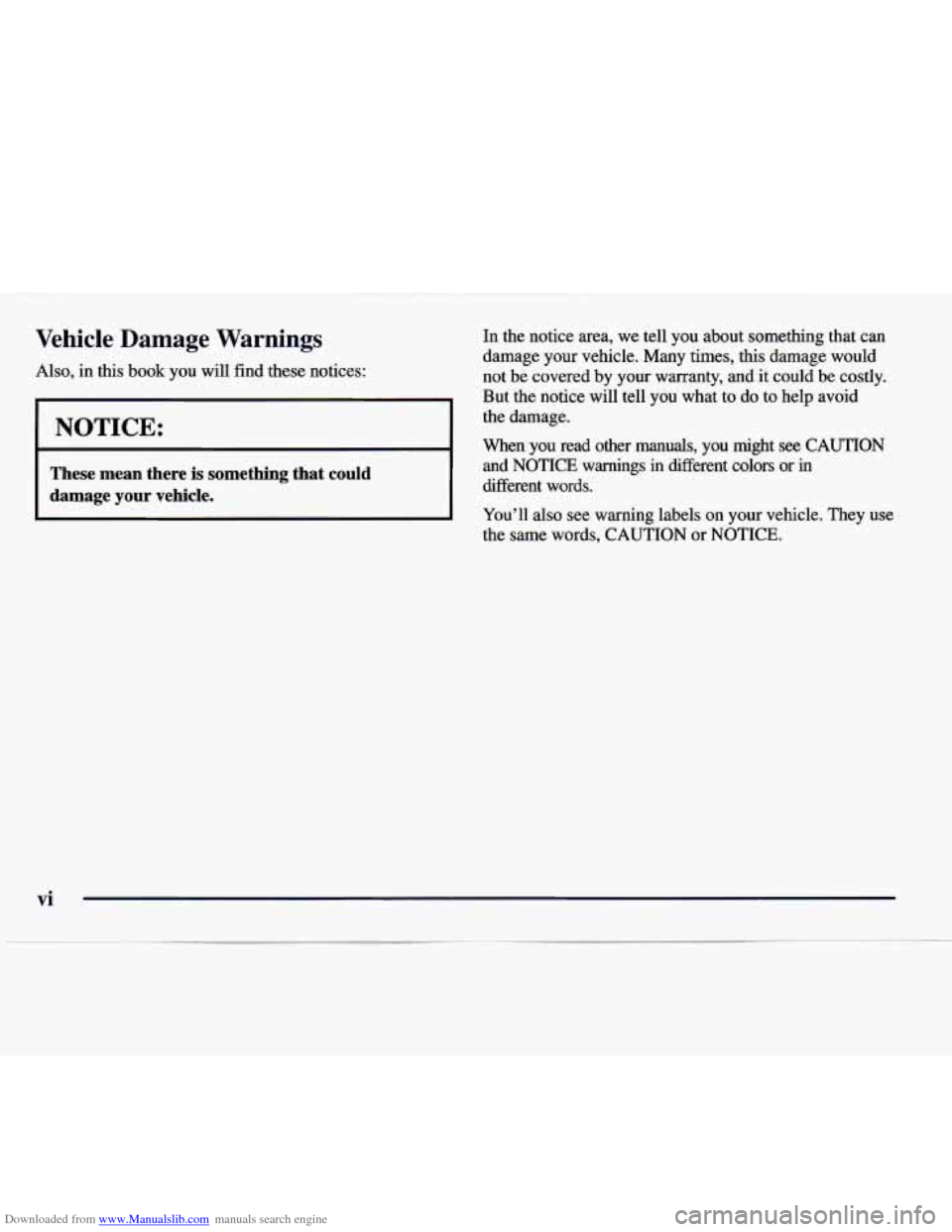
Downloaded from www.Manualslib.com manuals search engine Vehicle Damage Warnings In the notice area, we tell you about something that can
I i But the notice will tell you what to do to help avoid
damage your vehicle.
Many times, this damage would
Also, in this book you will find these notices: not be covered by your warranty, and it could be costly.
NOTICE:
the damage.
When you read other manuals, you might
see CAUTION
These mean there is something that could
damage your vehicle.
and NOTICE warnings in different colors or in
different words.
You’ll also see warning labels on your vehicle. They use
the same words, CAUTION or NOTICE.
vi
Page 8 of 338

Downloaded from www.Manualslib.com manuals search engine Vehicle Symbols
These are some of the symbols you may find on your vehicle.
For example,
these symbols
are used on an
original battery:
POSSIBLE A
CAUTION
INJURY
PROTECT EYES
BY
SHIELDING Q
CAUSTIC
BURNS AVOID
SPARKS
OR
FLAMES
SPARK
OR ,\I/,
COULD FLAME
EXPLODE BATTERY
These symbols are important
for you and
your passengers
whenever your
vehicle
is
driven:
DOOR LOCK
UNLOCK
FASTEN SEAT
BELTS
POWER
WINDOW
These symbols have
to do with
your lamps:
SIGNALS e 9
TURN
WARNING
A
HAZARD
FLASHER
RUNNING * 0
DAYTIME - 0
LAMPS '**
FOG LAMPS $0
These symbols
are on some
of
your controls:
WINDSHIELD
WIPER
WINDSHIELD DEFROSTER
WINDOW
DEFOGGER
VENTILATING FAN
These symbols are used on
warning and
indicator lights:
COOLANT -
TEMP -
CHARGING 1-1
BATTERY
SYSTEM
BRAKE
(a)
R
ENGINE OIL
PRESSURE
Wb
ANTI-LOCK (@)
BRAKES
Here are some other symbols
you may see:
FUSE
LIGHTER
m
HORN )tr
SPEAKER
b
FUEL B
vii
Page 62 of 338

Downloaded from www.Manualslib.com manuals search engine ,== -a .
Section 2 Features and Controls
Here you can learn about the many standard and optional features on your Catera, and information on starting,
shifting and braking. Also explained are the instrument panel and the warning systems that tell you
if everything is
working properly
-- and what to do if you have a problem.
2-2
2-
3
2-6
2- 10
2-1 1 2-12
2-
13
2- 14
2-15
2-16
2-
17
2-19
2-24 2-25
2-27
Keys
Door Locks
Remote Keyless Entry System (RKE)
Trunk
Theft
Theft-Deterrent (System)
Immobilizer
New Vehicle “Break-In”
Ignition Positions Starting Your Engine
.Engine Coolant Heater
Automatic Transmission Operation
Parking Brake
Shifting Into PARK
(P)
Shifting Out of PARK (P) 2-28
2-29
2-29
2-30
2-32
2-32
2-39
2-46
2-48
2-50
2-5
1
2-52
2-55
2-5 8
2-6
1
Parking Over Things That Burn
Engine Exhaust
Running Your Engine While You’re Parked
Windows Tilt Wheel
Turn Signal/Multifunction Lever
Lamps Mirrors
Storage Compartments
Ashtrays and Cigarette Lighter
Cellular Telephone
Sunroof
Universal Transmitter
Instrument Panel
Warning Lights, Gages and Indicators
Page 85 of 338
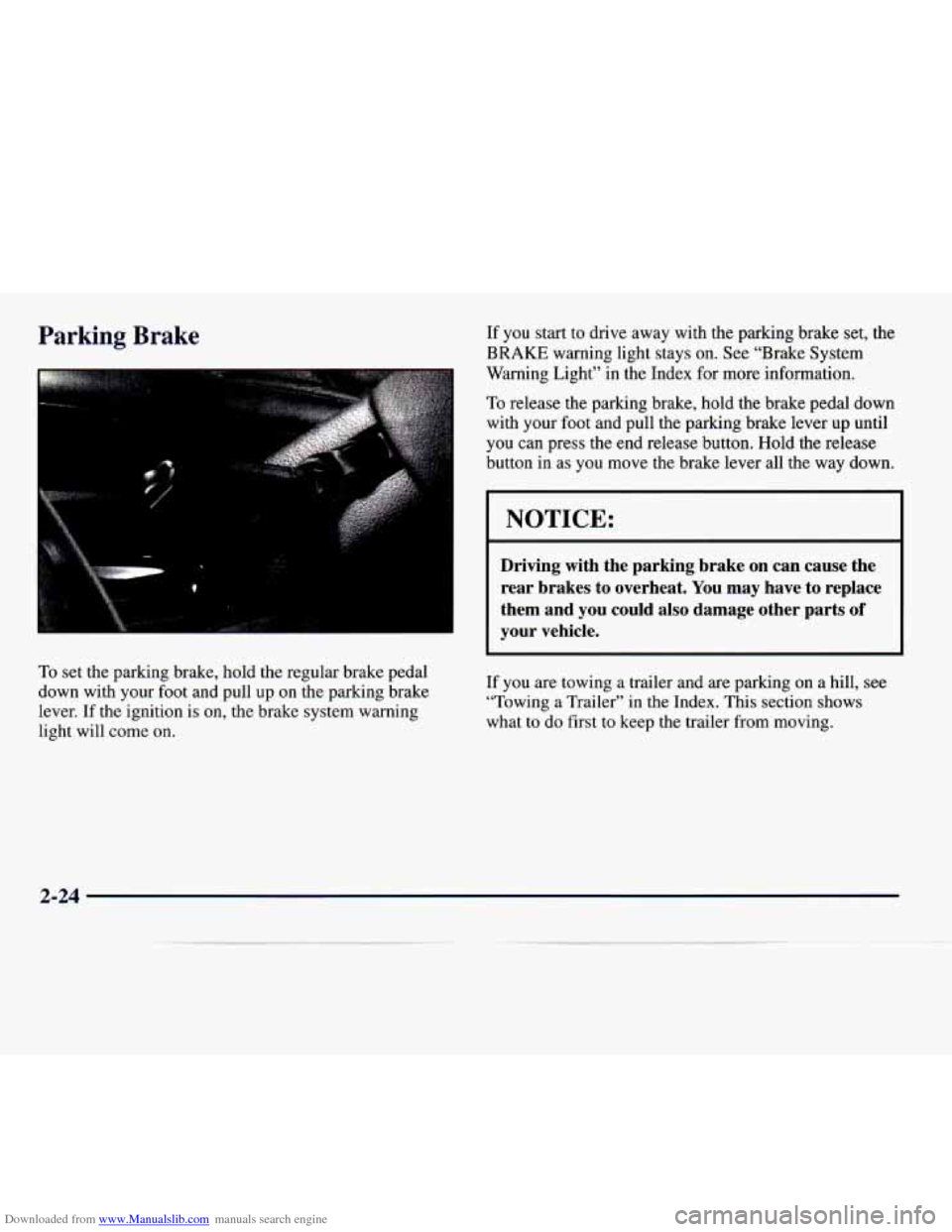
Downloaded from www.Manualslib.com manuals search engine Parking Brake If you start to drive away with the parking brake set, the
BRAKE warning light stays on. See "Brake System
Warning Light" in the Index for more information.
To release the parking brake, hold the brake pedal down
with your foot and pull the parking brake lever up until
you
can press the end release button. Hold the release
button in as
you move the brake lever all the way down.
1 .. .
0
NOTICE:
Driving with the parking brake on can cause the
rear brakes to overheat. You may have to replace
them and you could also damage other parts
of
your vehicle.
To set the parking brake, hold the regular brake pedal
down with your foot and pull
up on the parking brake
lever.
If the ignition is on, the brake system warning
light will come on. If you
are towing a trailer and
are parking on a hill, see
"Towing a Trailer" in the Index. This section shows
what to do first to keep the trailer from moving.
2-24
Page 95 of 338
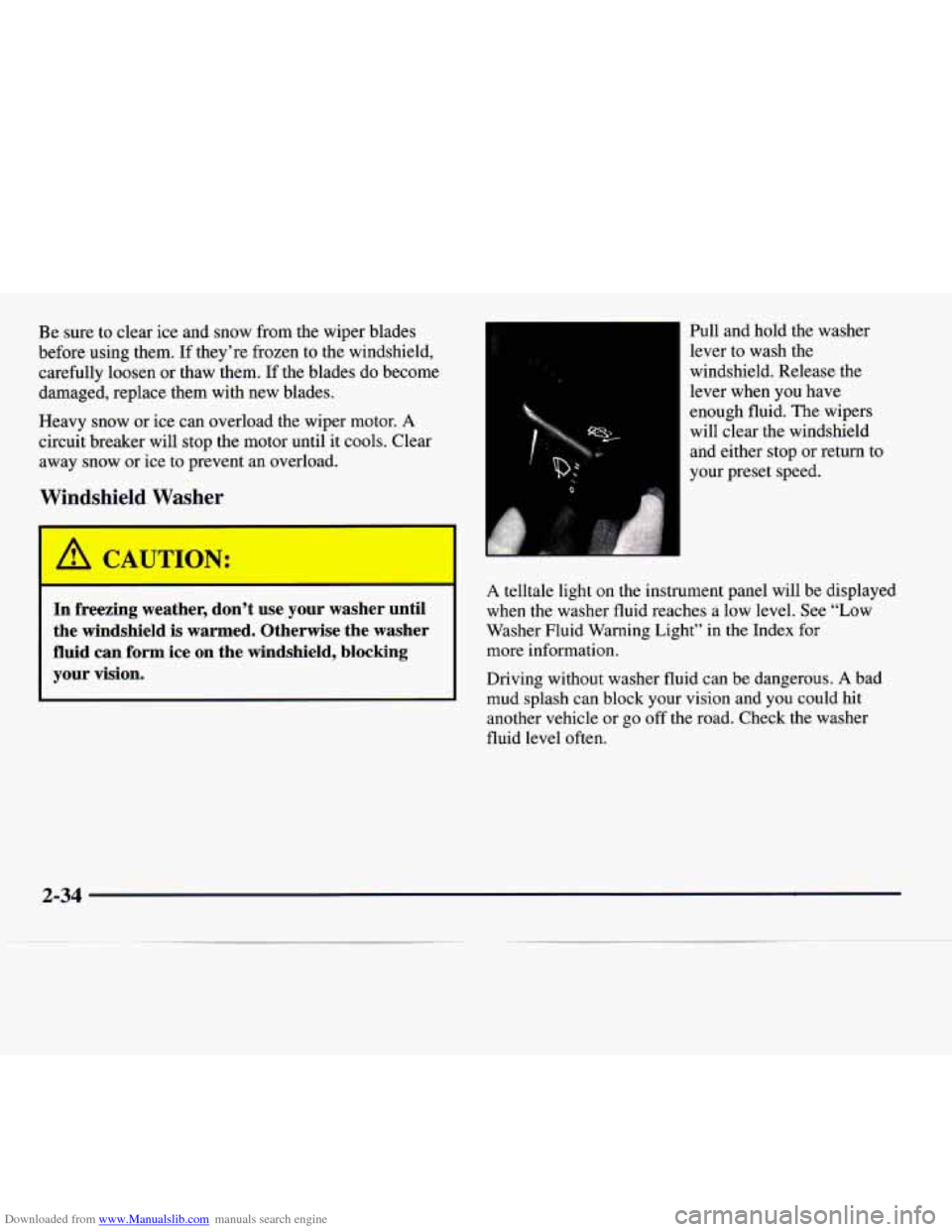
Downloaded from www.Manualslib.com manuals search engine Be sure to clear ice and snow from the wiper blades
before using them. If they’re frozen to the windshield,
carefully loosen
or thaw them. If the blades do become
damaged, replace them with new blades.
Heavy
snow or ice can overload the wiper motor. A
circuit breaker will stop the motor until it cools. Clear
away snow or ice to prevent an overload.
Windshield Washer
In freezing weather, don’t use your washer until
the windshield is warmed. Otherwise the washer
fluid can form ice on the windshield, blocking
your vision.
Pull and hold the washer
lever to wash the
windshield. Release the
lever when
you have
enough fluid. The wipers
will clear the windshield
and either stop or return to
your preset speed.
A telltale light on the instrument panel will be displayed
when the washer fluid reaches a low level. See “Low
Washer Fluid Warning Light” in the Index
for
more information.
Driving without washer fluid can be dangerous.
A bad
mud splash
can block your vision and you could hit
another vehicle or
go off the road. Check the washer
fluid level often.
2-34
Page 101 of 338
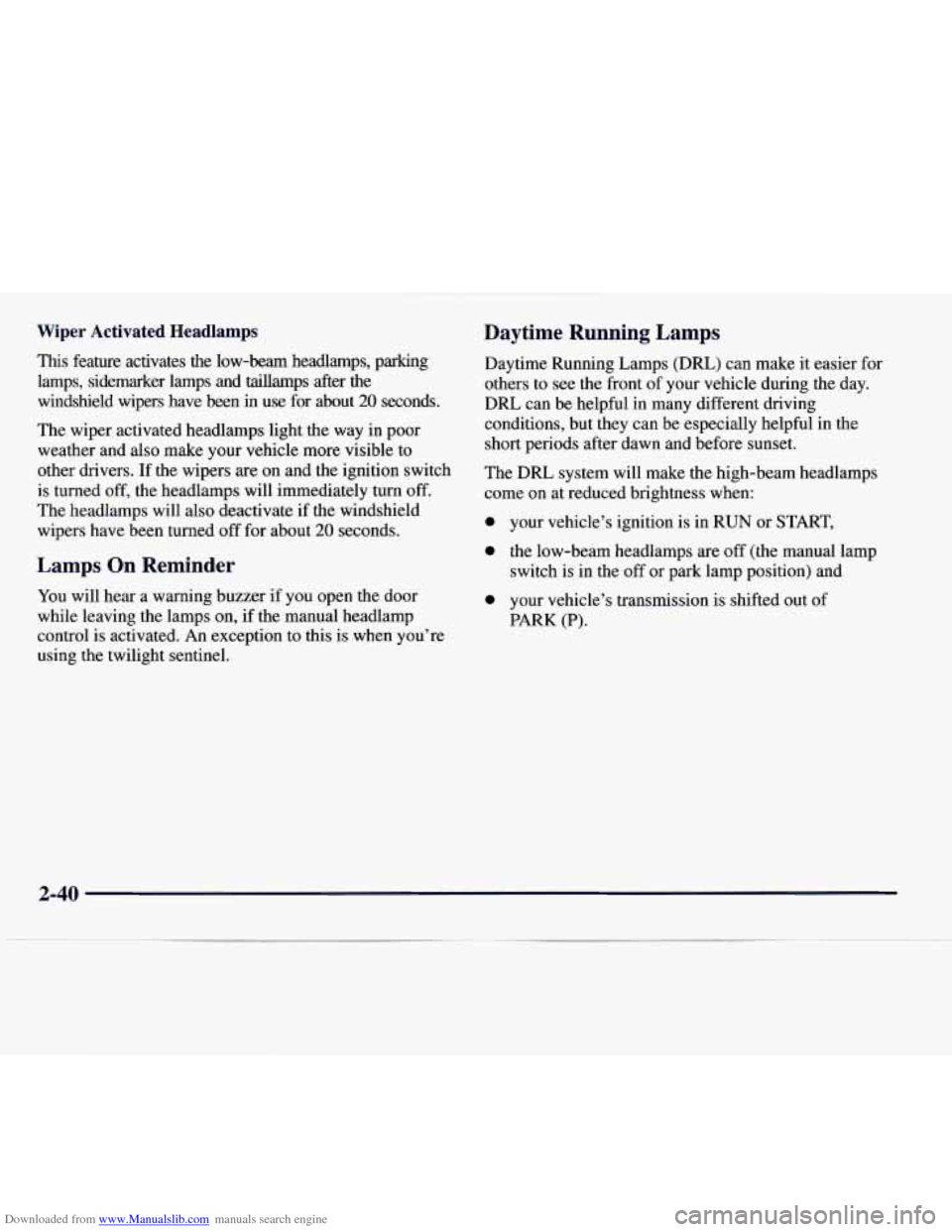
Downloaded from www.Manualslib.com manuals search engine Wiper Activated Headlamps
This feature activates the low-beam headlamps, parking
lamps, sidemarker lamps and taillamps after the
windshield wipers have been in use for about
20 seconds.
The wiper activated headlamps light the way in poor
weather and also make your vehicle more visible to
other drivers.
If the wipers are on and the ignition switch
is turned off, the headlamps will immediately turn off.
The headlamps will also deactivate if the windshield
wipers have been turned
off for about 20 seconds.
Lamps On Reminder
You will hear a warning buzzer if you open the door
while leaving the lamps
on, if the manual headlamp
control is activated. An exception to this is when you’re
using the twilight sentinel.
Daytime Running Lamps
Daytime Running Lamps (DRL) can make it easier for
others
to see the front of your vehicle during the day.
DRL can be helpful in many different driving
conditions, but they can be especially helpful in the
short periods after dawn and before sunset.
The DRL system will make the high-beam headlamps
come
on at reduced brightness when:
0 your vehicle’s ignition is in RUN or START,
0 the low-beam headlamps are off (the manual lamp
switch is in the
off or park lamp position) and
0 your vehicle’s transmission is shifted out of
PARK (P).
2-40
Page 120 of 338

Downloaded from www.Manualslib.com manuals search engine The instrument panel is designed to let you know at a glance how your Catera is running. You’ll know how fast
you’re going,
how much fuel you’re using and many of the other things you’ll need to know to drive safely and
economically. The main components
of the instrument panel are:
A. Air Outlets
K. Hood Release
B. Turn Signal/Multifunction Lever L. Hazard Warning Flasher Button
C. Driver’s Side Air Bag
M. Fuel Door Release Button
D. Instrument Cluster
N. Heated Front Seat OdOff Button
E. Windshield Washer Lever 0. Ashtray
E Comfort Controls P. Radio
G. Passenger’s Side Air Bag Q. Trunk Release Button
H. Lamp Controls
R. Traction Control OdOff Button
I. Horn S. Glove Box
J. Audio Steering Wheel Controls
2-59
Page 122 of 338
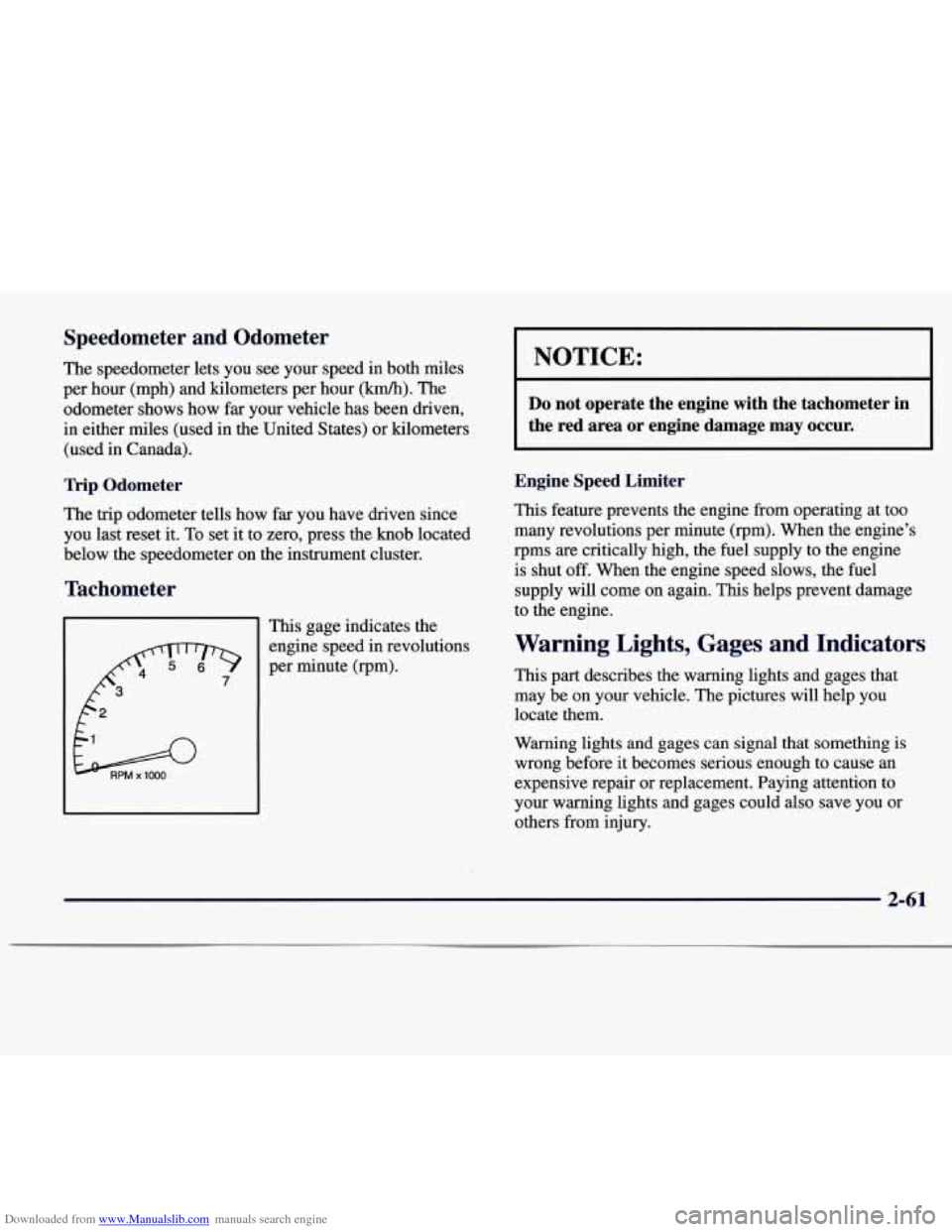
Downloaded from www.Manualslib.com manuals search engine Speedometer and Odometer
The speedometer lets you see your speed in both miles
per hour (mph) and kilometers per hour
(M). The
odometer shows how
far your vehicle has been driven,
in either miles (used in the United States) or kilometers
(used in Canada).
Trip Odometer
The trip odometer tells how far you have driven since
you last reset it. To set it to zero, press the knob located
below the speedometer on the instrument cluster.
Tachometer
This gage indicates the
engine speed in revolutions
per minute (rpm).
w RPM x 1000
NOTICE:
Do not operate the engine with the tachometer in
the red area or engine damage may occur.
Engine Speed Limiter
This feature prevents the engine from operating at too
many revolutions per minute (rpm). When the engine’s
rpms
are critically high, the fuel supply to the engine
is shut
off. When the engine speed slows, the fuel
supply will come on again.
This helps prevent damage
to the engine.
Warning Lights, Gages and Indicators
This part describes the warning lights and gages that
may be on your vehicle. The pictures will help you
locate them.
Warning lights and gages can signal that something is
wrong before it becomes serious enough to cause an
expensive repair or replacement. Paying attention to
your warning lights and gages could also save you or
others from injury.
2-61
Page 123 of 338

Downloaded from www.Manualslib.com manuals search engine Warning lights come on when there may be or is a
problem with one of your vehicle’s functions.
As you
will see in the details on the next few pages, some
warning lights come on briefly when you start the
engine just to let you know they’re working. If you are
familiar with this section, you should not be alarmed
when this happens.
Gages can indicate when there may be or is a problem
with one of your vehicle’s functions. Often gages and
warning lights work together to let you know when
there’s a problem with your vehicle.
When one of the warning lights comes on and stays on
when you are driving,
or when one of the gages shows
there may be a problem, check the section that tells you
what to
do about it. Please follow this manual’s advice.
Waiting to do repairs can be costly
-- and even
dangerous.
So please get to know your warning lights
and gages. They’re a big help.
Safety Belt Reminder Light
When the key is turned to RUN or START, a chime will
come on for about eight seconds to remind people to
fasten their safety belts, unless the driver’s safety belt is
already buckled.
The safety belt light will
also come on and stay on
for about four seconds,
then it will flash for about
60 seconds. If the driver’s
belt is already buckled,
neither the chime nor the
light will come
on.
2-62